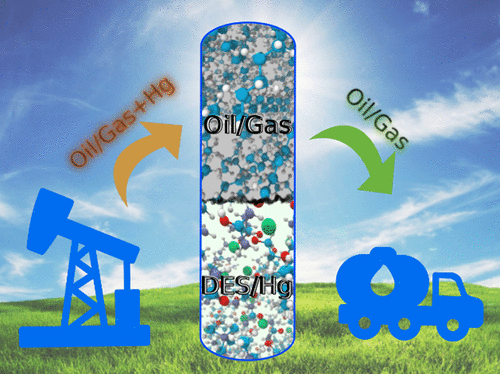Ind. Eng. Chem. Res. 57, 9222–9230 (2018)
Mercury capture is a major challenge in petroleum and natural gas processing. Recently, ionic liquids (ILs) have been introduced as mercury extractants from oil and gas. ILs yield very high mercury extraction efficiencies (>95%) from hydrocarbons, but their drawbacks include complex synthesis, toxicity, and difficult regeneration after mercury capture. In this work, a new technology using deep eutectic solvents (DESs) for elemental mercury (Hg0) extraction from hydrocarbons is demonstrated. DESs are an innovative class of designer solvents exhibiting similar properties as ILs, such as low vapor pressure and low flammability, but DESs are formed from inexpensive hydrogen-bond donor and acceptor compounds that are often biodegradable. In this work, four DESs were investigated including choline chloride:urea, choline chloride:ethylene glycol, choline chloride:levulinic acid, and betaine:levulinic acid, where the molar ratio is 1:2 in all cases. The DESs were tested for their thermal stability, density, and viscosity. Their performance for mercury extraction was assessed using saturated solutions in n-dodecane as the model oil. It was found that solvent to feed ratios of 1:1 and 2:1 at temperatures of 303.15 and 333.15 K and atmospheric pressure yield extraction efficiencies greater than 80% for all four DESs. First-principles molecular dynamics simulations probing the solvation in choline chloride:urea indicate a tight first coordination shell for mercury. Calculation of the Hg–Hg potential of mean force supports formation of a mercury–mercury polycation for a pair of Hg1+ ions, but not for pairs of Hg0 and Hg2+ species. Geometric analysis of the speciation and Mulliken population analysis support a redox reaction involving Hg2+ + 2Cl–.
